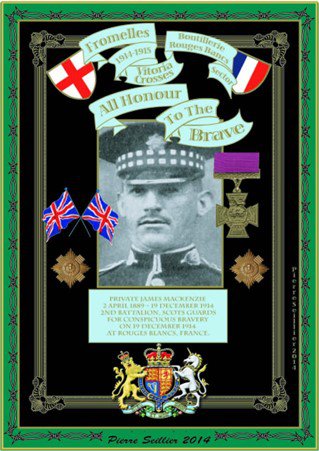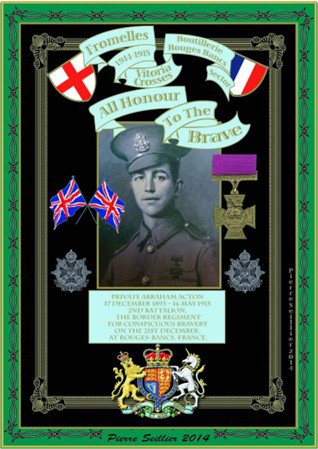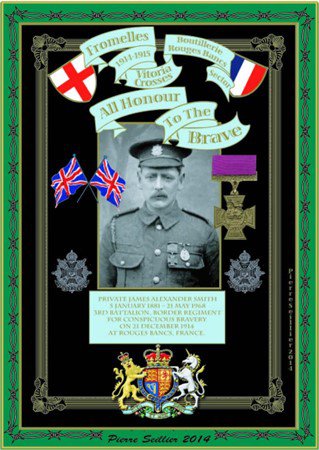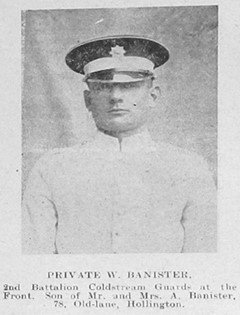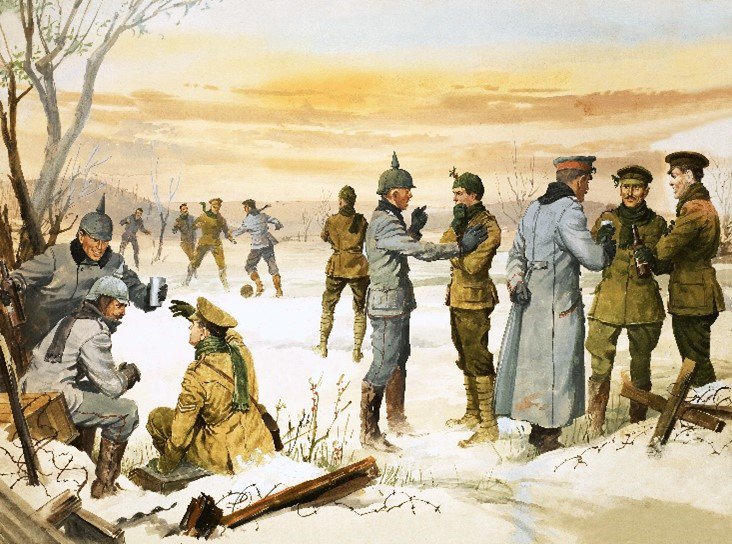What Happened During The Famous Christmas Truce Of 1914?
How Did Events Unfold At Fromelles?
The Christmas truce, which became famous during the First World War, was a series of unofficial ceasefires spread along the Western Front.
Known as Weihnachtsfrieden in German and Trêve de Noël in French, it lasted more than just Christmas Day itself, with soldiers from both sides crossing trenches to exchange greetings.
In some parts, men ventured into No Man's Land on Christmas Eve and Christmas Day to swap food and souvenirs they had received from home.
In some sectors there were also joint burial ceremonies, while some men are said to have played games of football, and other meetings ended with carol-singing.
But the truce wasn't completely widespread with fighting continuing in some sectors and 149 soldiers from the Commonwealth were killed or died on Christmas Day alone.
After festivities were over troops returned to fighting and in subsequent years, truces were not nearly as common - by 1916 they were no longer permitted at all.
Fromelles December, 1914
The Attack of the Rouges Bancs, Cardonnerie Farm, Delangre Farm.
The 3 Victoria Crosses And the Christmas Truce.
December 1914, the 20th Brigade, 7th Division, British Army, is on line in the Rue Petillon sector (Fleurbaix) in front of the German lines of Fromelles…
Order of Battle of the 7th Division, December, 1914.
| 20th Brigade | 2nd Bn, the Queen’s | |
| 1st Bn, the Grenadier Guards | 2nd Bn, the Royal Warwickshire Regt | |
| 2nd Bn, the Scots Guards | 1st Bn, the Royal Welsh Fusiliers | |
| 2nd Bn, the Border Regt | 1st Bn, the South Staffordshire Regt | |
| 2nd Bn, the Gordon Highlanders | 1/8th Bn, the Royal Scots | |
| 1/6th Bn, the Gordon Highlanders | (joined November 1914) | |
| (joined December, 1914) | Divisional Mounted Troops | |
| 21st Brigade | 1/1st Northumberland Hussars Yeomanry | |
| 2nd Bn, the Bedfordshire Regt | 7th Company, Army Cyclist Corps | |
| 2nd Bn, the Yorkshire Regt | Divisional Artillery | |
| 2nd Bn, the Royal Scots Fusiliers | XIV Brigade, RFA | |
| 2nd Bn, the Wiltshire Regt | XXII Brigade, RFA | |
| 22nd Brigade | XXXV Brigade, RFA | |
| 7th Divisional Ammunition Column RFA | Royal Army Medical Corps | |
| III Heavy Brigade RGA | 21st Field Ambulance | |
| No. 7 Pom Pom Section RGA | 22nd Field Ambulance | |
| (attached 25 September 1914 | 23rd Field Ambulance | |
| to 20 December, 1914) | Other Divisional Troops | |
| Royal Engineers | 7th Divisional Train ASC 39, 40, 42 | |
| 54th Field Company | And 86 Companies | |
| 55th Field Company | 12th Mobile Veterinary Section AVC | |
| 7th Divisional Signals Company |
18 December, 1914
An attack by 22nd Brigade, 2nd Queens and 2nd Royal Warwickshire, on the Well Farm position at la Boutillerie fails with heavy casualties. A further effort by 20th Brigade, 2nd Scots Guards and 2nd Border, in the Cardonnerie Farm sector, later in the day also fails.
18 December, 1914 Report by Captain LODER, 2nd Bn. The Scots Guards:
On Friday Dec 18th I was ordered by Captain PAYNTER to lead an attack on the German trenches with 2 Coys of the 2nd Bn Scots Guards. The RIGHT of the attack to rest on the FROMELLES – SAILLY Road, the LEFT of our line approximately 400 yards E of this point where the Border Regt joined our lines in No. 2 subsection.
This Regt was to carry on from this point. I was ordered to meet Captain ASKEW and arrange details with him at 3:45pm. The attack was timed for 6pm. It was arranged that at 6pm the men should be posted over the parapet and to crawl out under the wire fence and lie down. When this was done I was to blow my whistle and the line was then to move forward together and walk as far as they could until the Germans opened fire, and then rush the front line trenches. Having reached the trench I was to try and hold it, if occupied, and if unoccupied to push on to the second line.
The men carried spades and sandbags. F Coy Captain Sir F FITZWYGRAM, LF Captain H TAYLOR. At about three minutes to 6pm the men were hoisted over the parapet and lay down. I blew my whistle as loud as I could but, owing to the noise of our gun fire, it appears that it was not generally heard. F Coy being on the RIGHT and LF on the LEFT we began to move forward. After advancing about 60 yards I could see that in several places the line was not being maintained; some men moving forward faster than others. I could see this by the flash from the guns. I collected the men nearest to me and I found myself practically on the parapet before the Germans opened fire.
There was no wire entanglement at this point. We bayoneted and killed all the Germans we could see in the trench and then jumped down into it. There was a certain amount of shouting and confusion. I could not see far to my RIGHT or LEFT or tell what was happening on either flank. The position of the trench in which I found myself was not traversed for a distance of at least 25 yards. I ordered the men to make firing positions in the rear face of the trench. This was not easily done owing to the depth of the trench. I also told off some men to watch the flanks and, if the enemy appeared, to make traverses.
I remained in the trench some time, about one hour, and then thought I had better try and see what had happened at other places in the line. I got out of the trench, which I left in charge of Lieut SAUMAREZ, and told him to hang on. I found it impossible to get any information but could see a good many dead bodies lying close to the German parapet.
I decided to come back to report to Captain PAYNTER and explain what the situation was and suggest that, if the trench was to be held, reinforcements would have to be sent up. This he reported to the Brigadier as it then became apparent that the attack of the Border Regt had failed and also that 2 Coys RIGHT had only succeeded in getting into the trench in a few places. He was ordered not to send forward the remaining two Coys which were in reserve. I was then ordered to organise a digging party to sap to the German trench. This was attempted but, owing to a continuous German fire, it soon became clear that the distance, 180 yards, was too much. About 3am Lieut WARNER and a party of 10 men were led forward by Corporal JONES to the section of the German trench which was still intact. He reached it alright and found Lieut SAUMAREZ wounded [in the hand and that a stretcher was sent out, and, with great difficulty, Lieut SAUMAREZ was removed]. Lieut WARNER was ordered to withdraw. Just before dawn he accomplished this without loss. Shortly after the attack was launched Lieut OTTLEY and a party from G Coy were sent up to reinforce Lieut HANBURY TRACY. While at the head of his men he was mortally wounded before reaching the German trench and the rest of the party don’t appear to have been able to reach the trench. Corporal MITCHELL, with great courage, brought back Lieut OTTLEY [Lieut OTTLEY was awarded a DSO.]
During this attack the Germans don’t appear to have used any bombs or hand grenades. The crossfire from well-placed German Machine guns played a big part and this accounts for our very heavy casualties amounting to nearly 50%, about 180 men being killed or wounded. Among the officers:
Killed: Captain H TAYLOR, LF Coy; Lieut Hon HANBURY TRACY F Coy
Missing: Lieut NUGENT LF Coy [believed to have been killed]
Wounded: Lieut SAUMAREZ LF Coy; Captain Sir F FITZWYGRAM F Coy
Died of Wounds: 2/Lieut OTTLEY G Coy
Captain LODER was the only officer who returned unwounded.
Pte CLARKSON has an Iron Cross which he found on a dead German officer.
19 December, 1914
Private MACKENZIE 2nd Battalion, Scots Guards rescued a severely wounded man from the front of the German trenches under a very heavy fire and after a stretcher party had been compelled to abandon the attempt. Private MACKENZIE was killed later on that day while trying to carry out a similar act. For his action, Private MACKENZIE was awarded the Victoria Cross.
Private MACKENZIE has no known grave but his name is listed on panel 1 the Ploegsteert Memorial to the Missing in Berks Cemetery Extension near Ploegsteert in Hainaut, Belgium. There is a memorial tablet at Troqueer parish church, Dumfries. His Victoria Cross is displayed at The Guards Regimental Headquarters (Scots Guards RHQ), London, England.
20 December, 1914
Local truce on the front of 22nd Brigade; Germans begin by taking in British wounded from no man’s land. There is some contact according to Lt G HEINEKEY of 2nd Queen’s, it lasted all morning. Lt Henry BOWER, 1st South Staffordshire and at least one soldier of the 2nd Queen’s were killed by rifle fire from neighbouring units while assisting with the wounded. A similar activity took place of the front of the 20th Brigade.
21 December, 1914
Privates Abraham ACTON and James Alexander SMITH of the 2nd Battalion, Border Regiment voluntarily leave their trenches to rescue a wounded man exposed to fire near the enemy trenches for 75 hours, the same day they still voluntarily left of their trench under heavy fire to put in shelters another wounded man. They were under fire for 60 minutes while transporting them safely injured. No truce day… Both have received for their bravery the Victoria Cross. Unfortunately Private ACTON was killed at Festubert, on May 16, 1915, but his body was never found. He is commemorated on the Touret Memorial at Richebourg. Private SMITH died in 1968.
[Historical note: The vicinity in which MacKenzie, Acton and Smith’s actions took place became known as VC Corner. Following the end of WW1, it became the site for the cemetery now named VC Corner. So a cemetery which has been built as the final resting place of unidentifiable remains of Australian soldiers killed in 1916, obtained its name from the actions of three British VC winners in December, 1914.]
23 December, 1914
A German soldier, Karl Aldag, reports that both sides had been heard singing hymns in the trenches. German troops coming into the lines bring Christmas trees. Some mem begin to place them on the parapets of the fire trenches. Local truce on the front of 23rd Brigade, 8th Division (Picantin, Fauquissart sector).
24 December 1914. Christmas Eve across the battlefields of France and Belgium.
The weather changes to a hard frost. This makes trench conditions a little more bearable. 98 British soldiers die on this day, many are victims of sniper fire. A German aeroplane drops a bomb on Dover: the first air raid in British history. During the afternoon and early evening, British infantry are astonished to see many Christmas trees with candles and paper lanterns, on enemy parapets. There is much singing of carols, hymns and popular songs, and a gradual exchange of communication and even meetings in some areas. Many of these meetings are to arrange collection of bodies. In other places, firing continues. Battalion officers are uncertain how to react; in general they maintain precautions. The night brings a clear, still air with a hard frost.
British and German troops fraternise at Christmas 1914.
25 December 1914, Christmas Day at Fromelles
Burial: Men of 20th Brigade bury their dead of the attack of 18 December, alongside German soldiers engaged in the same activity. Christmas Day, 1914.
Units behind the lines attend church services and have in most cases arranged Christmas dinners which are taken in barns and shattered buildings. In the front lines, the fraternisation of Christmas Eve is continued throughout the day: not all units know about it, and it is not universal but is widespread over at least half of the British front. Many bodies that have been lying out in no man’s land are buried, some in joint burials. Many men record the strange and wonderful events; many men exchange tokens or addresses with German soldiers, many of whom speak English. 81 British soldiers die on this day; a few die in areas that are otherwise peaceful and with fraternisation going on, victims of alert snipers. In other areas, there is considerable activity: 2nd Grenadier Guards suffer losses in a day of heavy fighting. As night fell, things grew quiet as men fell back to their trenches to take whatever Christmas meal that had been provided for them.
25 December 1914, Christmas Day across the battlefields of France and Belgium
For a single day, peace seemed to reign over the Western Front or at least individual sections of the trench network. Fighting was still raging on other parts of the frontline.
Remember, the trench networks extended from the French and Belgian coasts to Switzerland, a distance of several hundred miles.
British and Indian troops were concentrated in Northern France and Southern Belgium. Not all of them experienced the Yuletide ceasefire.
In the Commonwealth War Graves Commission’s records, they commemorate around 149 men who died or were killed in France and Belgium on Christmas Day 1914.
To be clear: while peace did break out in certain sections of the Western Front, it was by no means a universal occurrence.
For example, the 2nd Division, stationed in the Festubert to Cuinchy Sector in the Pas-de-Calais, were under fire, especially the 2/Coldstream and 2/Grenadier Guards.
The 2nd Regiment had marched several miles from Bethune to reach their positions on 23rd/24th December in trenches east of Le Touret.
Conditions in their trenches were appalling with slush, mud, and rainwater coming in over the tops of their boots. In some cases, men were standing waist-deep in muddy water.
Whereas some British troops were serenading by German carollers on Christmas Eve, 2/Grenadier Guards were instead met by gunfire. The Battalion took a number of losses during the festive period, including 2nd Lieutenant John H.G. Neville, who had been with 2/Grenadier Guards for a scant few days.
One member of the Grenadier Guards present on Christmas Day wrote home saying: “Perhaps you read of the conversation on Christmas Day. It is all lies. The sniping went on just the same; in fact, our Captain was wounded, so don’t believe what you see in the papers.”
Christmas Day Casualties Away From Fromelles
Below are the stories of two casualties that fell during the Yuletide period.
Private William Banister
Private William Banister was one of the men of the 2/Coldstream Guards engaged in bitter trench-to-trench warfare on Christmas Day 1914.
The truce was certainly not in effect on Banister and the Coldstream Guards’ part of the line.
A hail of sniper fire claimed several Guardsmen’s lives on Christmas morning. The unit’s war diary records that the accuracy of German fire could only be achieved by the use of telescopic sites.
William was one of the victims of the furious fusillade. He was just 18 years old when he was killed. He is buried in Le Touret Military Cemetery.
Lieutenant Leonard Castel Campbell Rogers
Born in Cuttack, Orissa, India, Lieutenant Leonard Castel Campbell Rogers was serving as a Lieutenant with the 7th Gurkha Rifles in the Indian Army prior to the breakout of the Great War.
During Christmas Time 1914, Leonard and his unit were engaged in the fighting around Festubert. As we’ve discussed, combat slowed on this part of the Western Front during the festive period but did not stop.
On Christmas Eve, one of Leonard’s men lay wounded in front of his unit’s position. The man had been lying in No Man’s Land for some time, around 48 hours, but no opportunity to safely rescue him had presented itself.
Leonard led a group of men to rescue his wounded comrade under a terrific burst of enemy gunfire. Unfortunately, Leonard was struck by an errant bullet and was mortally wounded. He died on Christmas morning.
For his gallantry and bravery under fire, Leonard was posthumously awarded the Military Cross, as reported in the 23rd February 1915 edition of the Edinburgh Gazette.
Leonard is buried in Le Touret Military Cemetery.
26 December 1914, Boxing Day at Fromelles
Some snow. In some areas, the friendly spirit was resumed. Gradually however, officers and men on both sides began to resume normal trench caution. The atmosphere in general remained relaxed as Brigade and Battalion officers took a pragmatic view of events. The chance was taken to carry out work that would otherwise have been hazardous. By now, however, news of the truce was reaching higher commands. General Sir Horace Smith-Dorrien requested particulars of those units and officers who took part, with a view to disciplinary action. In the event, no action was taken against any unit or officer. 62 British soldiers die on this day.
27-31 December, 1914 across the battlefields of France and Belgium
The weather turns wet again, with rain, sleet and storms. There were instances of men disappearing in the flooded trenches. Yet in some areas the friendly mood remained for several days and there was almost no firing, although open fraternisation gradually died away. On New Year’s Eve, there was a certain amount of singing and exchange of messages, but no truce as such.
Testimonies from Fromelles:-
Located west of Lille and about 30 kilometres south of Ypres – At the village of Fromelles in France soldiers entered the Gordon Highlanders, the approximately 80-metre wide no man’s land to retrieve their fallen. A common service was held. Psalm 23 (“The Lord is my shepherd…”) was spoken first in English and then a pastor of the regiment in German by an English student. The Germans were on one side, the British on the other, all of them had taken off their headgear, the second lieutenant Arthur Pelham Burn recalls in his diary: “The Germans formed up on one side, the English on the other, the officers standing in front, every head bared. Yes, I think it was a sight one will never see again.”
“At the same place, the British Captain listed in a letter that he had heard sporadic shots and a gun in the distance, but there has otherwise been silence. He allowed some of his soldiers to meet with the Germans. Then exchanged in no man’s land tobacco and talked to the extent that was possible.”
Most of the reports submitted by the British side, the most famous of Captain Sir Edward Hulse (like 1915) of the Scots Guards, who, when he had come back from headquarters, realized that there was fraternization.
“Scots and Huns were fraternizing in the most genuine possible manner. Every sort of souvenir was exchanged, addresses given and received, photos of families shown, etc. One of our fellows offered a German a cigarette; the German said ‘Virginian?” Our fellow said, ‘Aye, straight-cut”, the German said ‘No thanks, I only smoke Turkish!’ […] it gave us all a good laugh.”
Captain Loder 2nd Bn, the Scots Guards:
“25th Dec 1914 – Fromelles
Xmas, fine and frosty, one man wounded. On the night of Christmas Eve, the German trenches opposite those occupied by the battalion were lit up with lanterns and there were sounds of singing. We got into conversations with the Germans who were anxious to arrange an armistice during Xmas. A scout named F Menzies went out and met a German patrol and was given a glass of whisky and some cigars, and a message was sent back saying that if we didn’t fire at them they would not fire at us. There was no firing during the night. Early on Xmas morning a party of Germans 158 Regiment came on to our own wife fence, and a party from our trenches went out to meet them. They appeared to be most amiable and exchanged souvenirs, cap stars and badges. Our men gave them plum puddings which they much appreciated. Further down the line we were able to make arrangements to bury the dead who had been killed on Dec 18-19 and were still lying between the trenches. The Germans brought the bodies to a half way line and we buried them. Detachments of British and Germans formed in line and a German and English Chaplain read some prayers alternately. The whole of this was done in great solemnity and reverence. ... I talked to several officers and men… Another officer who could not speak English or French appeared to express his feelings, pointed to the dead and reverently said “Les Braves” which shows that the Germans do think something of the British Army. The men I spoke to were also reticent. They appeared generally tired of fighting, and wanted to get back to their previous employments. Some lived in England. One man told me he had been seven years in England and had married last March. Another said he had a girl who lived in Suffolk and said it had been impossible to communicate with her through Germany since war began.”
British Units Which Took Part In The Truce
7th Division at Fromelles Delangre Farm/Rouges Bancs/Delval Farm sector.
20th Brigade:
2nd Border
2nd Gordon Highlanders
1/6th Gordon Highlanders
2nd Scots Guards
Divisional Mounted Troops
A and B Squadrons, the Northumberland Hussars (dismounted, used as infantry)
German Units Which Took Part In The Truce
13th Division Rouges Banks sector.
25th Brigade:
7 Lothringisches Infanterie-Regiment No 158
The Football Match
Legend has it that an organised football match took place between British and German soldiers on Christmas Day 1914. It remains part of the enduring myth associated with the Christmas Truce. But precisely where did it or them take place? It is more likely that spontaneous kickabouts took place up and down the line, rather than a single, organised one-off game.
No football match took place at Fromelles as the previous testimonials will confirm.
There are lots of eyewitness testimonials from both sides saying that an impromptu kickabout of a football or something improvised to suggest a football match, took place at different sectors on the Western Front, but not at Fromelles.
For example, local accounts refer to a game played in the Ploegsteert sector in Belgium, not in the Rouges Bancs at Fromelles.
In typical fashion, the Germans are said to have bested their British opponents.
“Suddenly a Tommy came with a football, kicking already and making fun, and then began a football match,” wrote Lieutenant Johannes Niemann of the 133rd Saxon Infantry Regiment. “We marked the goals with our caps. Teams were quickly established for a match on the frozen mud, and the Fritzes beat the Tommies 3-2.”
With thanks to the following in compiling this article:
- material provided by Pierre Seillier
- Terri Blom Crocker: the Myth of the Christmas Truce Soccer Match (internet 25 December, 2015)
- Commonwealth War Graves Commission: Peace in No Man’s Land? The Truth Behind the Christmas Truce (internet 15 December, 2022).
